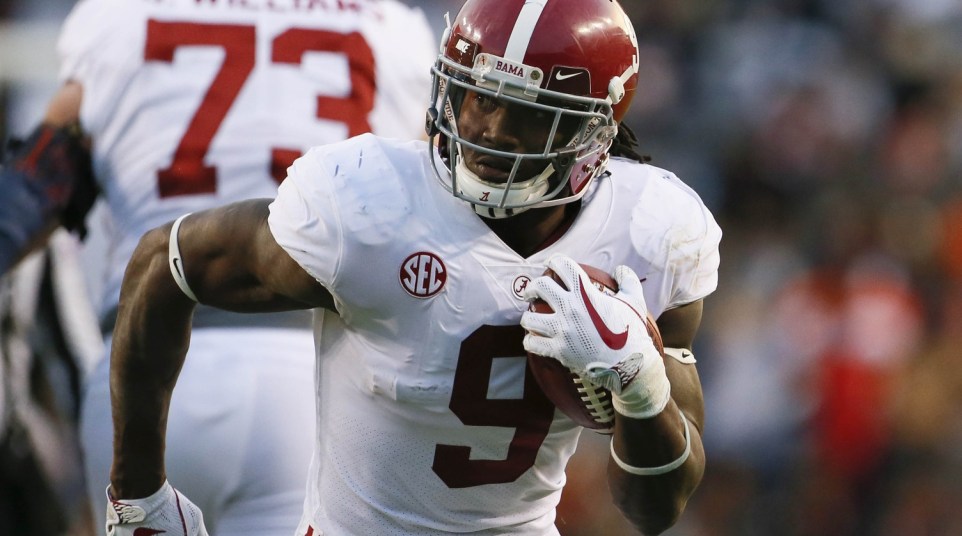
Is Bo Scarbrough the key to Alabama's title drive?
A lot of factors contributed to Alabama’s National Championship Game appearance in 2016. It’s possible that none of them were as important as Bo Scarbrough’s emergence in the postseason.
Between the SEC Championship Game against Florida and the first round of the College Football Playoff against Washington, Scarbrough ran for 271 yards and four touchdowns — averaging 9.03 yards per carry.
The Tuscaloosa native was showing off power, balance and the breakaway speed needed to be Tide’s workhorse running back — as evidenced by this 68-yard touchdown run against Washington.
Never Forget… Bo Scarbrough 68 Yd TD Run Against Washington #RollTide pic.twitter.com/2FMgoPh1fj
— BamaInsider.com (@bamainsider) July 28, 2017
Against Clemson in the national title game, Scarbrough’s success continued. He reeled off 100 total yards of offense (93 rushing, 7 receiving) and two touchdowns on 18 touches, and Alabama clearly looked like the better team.
Then, the injury bug crept back up for the Alabama running back, and he was lost for the rest of the game with a broken leg.
Alabama’s offense stalled from that point as the rest of the running backs only put up 40 yards on the ground.
We all know how the game turned out as well. Clemson edged Alabama in the final seconds — walking away with a 35-31 victory thanks to a 2-yard touchdown pass from Deshaun Watson to Hunter Renfrow with one second left.
Since that game, Scarbrough has long been recovered from the leg injury that that crippled Alabama’s success offensively.
But he has not returned to his role as Alabama’s featured running back.
In fact, Scarbrough has been limited to a rotational role behind Damien Harris. They’ve seen roughly the same amount of carries this season (110 for Harris compared to 108 for Scarbrough) but Harris has turned that into almost double the production (906 yards to 549) and more touchdowns (11 to 8).
It seems Scarbrough has been more of a battering ram this season compared to last year when he was showing an elite skill set. That doesn’t mean the abilities are gone, however, so the junior could return to his level of play from the tail end of ’16.
There actually seems to be evidence that supports him returning to that level in recent weeks.
While Scarbrough only received 11 carries over Alabama’s past two games, he posted two of his three best yards per carry performances (10.8 and 7.7) during that time frame. In addition, he had his two longest runs of the season — a 44-yard scamper against Mercer and a 21-yard touchdown against Auburn.
Scarbrough looked particularly impressive against Auburn despite his limited carries. He showed some of the same confidence that made him such an effective runner in the postseason last year.
He doesn’t have a 100-yard rushing game this season, but he had only one heading into the Playoff in ’16. He added one more in the CFP, with a career high of 180 yards against Washington.
Another thing working against Scarbrough is that he has never received 20 carries in a single game.
He could become the Tide’s spark to help get them over the edge against a formidable Clemson defensive front seven, but Scarbrough hasn’t proven that he is capable of a heavy workload, either.
If he is going to be the X-factor for Alabama, he must do it on a limited snap count. There is no reason to believe that offensive coordinator Brian Daboll is going to suddenly put Scarbrough in a position to receive a majority of the carries.
Harris, Josh Jacobs and even true freshman Najee Harris have been effective this year — all three have more yards per carry than Scarbrough. The older Harris checks in at No. 8 in the country (8.24) in that department.
So it wouldn’t be wise to hand over a significant majority of the carries to Scarbrough, but it also wouldn’t be outlandish to think that he could handle the most carries — maybe somewhere between 12 and 15.
The bottom line is, Alabama has to do a better job of getting the ball to its running backs, so why not see what Scarbrough can do with an uptick in usage?
To expect him to handle — or even deserve — 30 to 40-plus carries like Derrick Henry did in 2015 isn’t currently within the realm of possibility. He can, however, do well with the same type of workload he had late last season (15.3 carries per game over his last three).
If Alabama gets that guy back, it could create some issues for Clemson’s run defense, which ranks No. 13 in the country.
